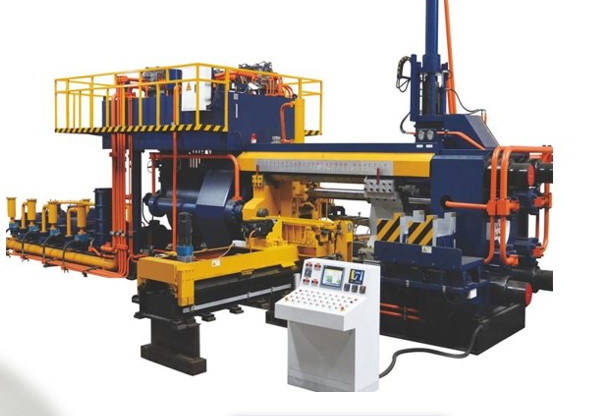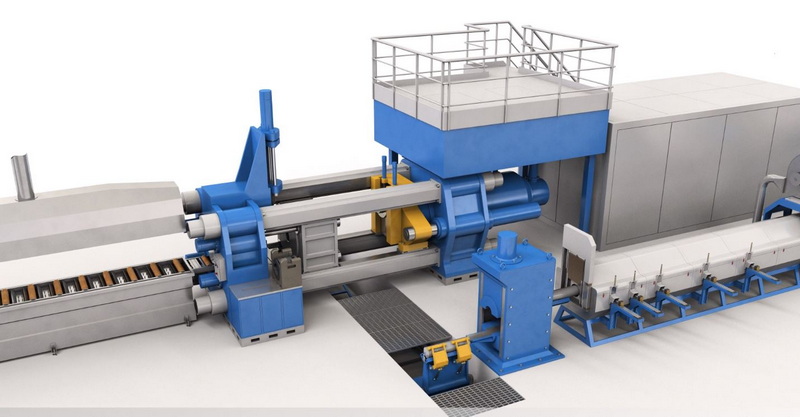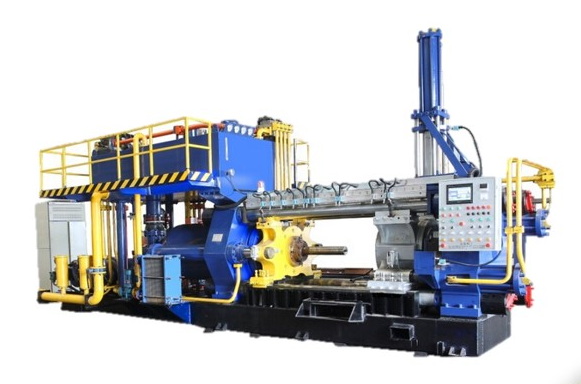Content Menu
● Introduction to Aluminum Extrusion Press Machines
● The Aluminum Extrusion Process: A Step-by-Step Guide
>> 1. Billet Preparation
>> 2. Die Preparation
>> 3. Extrusion
>> 4. Cooling and Stretching
>> 5. Cutting and Aging
>> 6. Finishing
● Components of an Aluminum Extrusion Press Machine
● Benefits of Aluminum Extrusion Press Machines
● Applications of Aluminum Extrusion
● Advancements in Aluminum Extrusion Technology
● Choosing the Right Aluminum Extrusion Press Machine
● The Future of Aluminum Extrusion
● Conclusion
● Frequently Asked Questions
Introduction to Aluminum Extrusion Press Machines
Aluminum Extrusion Press Machines are the cornerstone of modern metal forming technology, playing a crucial role in shaping the world around us. These powerful machines are designed to transform raw aluminum billets into intricate profiles and shapes that find applications across various industries. From construction and automotive to aerospace and consumer goods, the versatility of aluminum extrusion has made it an indispensable process in manufacturing.
The Aluminum Extrusion Process: A Step-by-Step Guide
The aluminum extrusion process is a fascinating journey that begins with a simple billet and ends with complex, precisely shaped profiles. Let's break down this process into its key stages:
1. Billet Preparation
The process starts with an aluminum billet, typically a solid cylindrical block of aluminum alloy. These billets are cut to specific lengths depending on the desired final product. Before extrusion, the billet is preheated to a temperature range of 800°F to 925°F (427°C to 496°C). This heating process softens the aluminum, making it more malleable and easier to extrude.
2. Die Preparation
While the billet is being heated, the extrusion die is prepared. The die is a precision-engineered tool with an opening that matches the cross-section of the desired profile. It's crucial that the die is properly designed and maintained to ensure the quality of the final product.
3. Extrusion
Once the billet reaches the optimal temperature, it's transferred to the extrusion press. The press uses immense hydraulic force to push the heated aluminum through the die. As the aluminum is forced through the die opening, it takes on the shape of the die profile. This process can be likened to squeezing toothpaste out of a tube, but on an industrial scale and with much higher precision.
4. Cooling and Stretching
As the aluminum emerges from the die, it's cooled using air or water. The cooling process is carefully controlled to ensure the extruded profile maintains its shape and develops the desired mechanical properties. After cooling, the extrusion is stretched to straighten it and relieve internal stresses.
5. Cutting and Aging
The extruded profile is then cut to the required length. Depending on the alloy and desired properties, the aluminum may undergo an aging process. Aging can be natural (at room temperature) or artificial (in an oven), and it helps to enhance the strength and hardness of the aluminum.
6. Finishing
Finally, the extruded profiles may undergo additional finishing processes such as anodizing, painting, or powder coating to enhance their appearance and durability.

Components of an Aluminum Extrusion Press Machine
An Aluminum Extrusion Press Machine is a complex piece of equipment composed of several key components:
1. Main Cylinder: This is the heart of the extrusion press, providing the force necessary to push the aluminum through the die.
2. Container: The container holds the heated billet and guides it towards the die.
3. Ram: The ram is the part that directly applies pressure to the billet, forcing it through the die.
4. Die Holder: This component securely holds the extrusion die in place during the process.
5. Platen: The platen supports the die and die holder, withstanding the extreme pressures of extrusion.
6. Hydraulic System: This system generates and controls the immense force required for extrusion.
7. Control Panel: Modern extrusion presses are equipped with sophisticated control systems that monitor and adjust various parameters throughout the process.
Benefits of Aluminum Extrusion Press Machines
The use of Aluminum Extrusion Press Machines offers numerous advantages in manufacturing:
1. Versatility: These machines can produce a wide range of shapes and profiles, from simple to highly complex.
2. Cost-Effectiveness: For medium to high volume production, extrusion is often more economical than other manufacturing methods.
3. Strength-to-Weight Ratio: Extruded aluminum profiles offer an excellent balance of strength and lightness.
4. Precision: Modern extrusion presses can achieve tight tolerances, ensuring consistency across production runs.
5. Surface Finish: The extrusion process can produce profiles with smooth surfaces, reducing the need for additional finishing.
6. Sustainability: Aluminum is 100% recyclable, and the extrusion process itself produces minimal waste.
Applications of Aluminum Extrusion
The versatility of aluminum extrusion has led to its adoption across a wide range of industries:
1. Construction: Window frames, door frames, curtain walls, and structural components.
2. Automotive: Body frames, heat sinks, trim pieces, and crash management systems.
3. Aerospace: Aircraft fuselage components, wing spars, and seat tracks.
4. Electronics: Heat sinks, LED housings, and enclosures for electronic devices.
5. Renewable Energy: Solar panel frames and mounting systems for photovoltaic installations.
6. Consumer Goods: Furniture components, sporting goods, and household appliances.
Advancements in Aluminum Extrusion Technology
The field of aluminum extrusion is continually evolving, with new technologies enhancing the capabilities of Aluminum Extrusion Press Machines:
1. Increased Press Capacities: Modern presses can extrude larger billets, allowing for the production of larger and more complex profiles.
2. Improved Control Systems: Advanced sensors and software enable real-time monitoring and adjustment of the extrusion process, improving quality and consistency.
3. Multi-Hole Dies: These allow for the simultaneous extrusion of multiple profiles, increasing productivity.
4. Eco-friendly Practices: Innovations in billet heating and cooling systems are reducing energy consumption and environmental impact.
5. Integration with Industry 4.0: Extrusion presses are becoming part of smart manufacturing systems, with data analytics and predictive maintenance capabilities.
Choosing the Right Aluminum Extrusion Press Machine
Selecting the appropriate Aluminum Extrusion Press Machine is crucial for efficient and high-quality production. Factors to consider include:
1. Press Capacity: The tonnage of the press should match your production requirements.
2. Billet Size: Consider the maximum billet diameter and length the press can handle.
3. Extrusion Speed: Higher speeds can increase productivity but may affect quality for certain profiles.
4. Control System: Look for presses with advanced control systems for better process management.
5. Energy Efficiency: Modern presses with energy-saving features can reduce operational costs.
6. Maintenance Requirements: Consider the ease of maintenance and availability of spare parts.

The Future of Aluminum Extrusion
As we look to the future, the aluminum extrusion industry is poised for further innovation:
1. Artificial Intelligence: AI-driven process optimization could lead to even greater efficiency and quality control.
2. New Alloys: Development of new aluminum alloys could expand the capabilities of extrusion, opening up new applications.
3. Additive Manufacturing Integration: Combining extrusion with 3D printing technologies could create hybrid manufacturing processes.
4. Sustainability Focus: Increased emphasis on recycling and energy efficiency will drive further improvements in extrusion technology.
5. Miniaturization: Advancements in die design and press control may enable the production of even smaller and more intricate profiles.
Conclusion
Aluminum Extrusion Press Machines have revolutionized the manufacturing industry, offering a unique combination of versatility, efficiency, and precision. As technology continues to advance, these machines will play an increasingly important role in shaping our built environment and the products we use every day. From skyscrapers to smartphones, the impact of aluminum extrusion is all around us, a testament to the power and potential of this remarkable manufacturing process.

Frequently Asked Questions
1. Q: What is the maximum size of aluminum profile that can be extruded?
A: The maximum size depends on the capacity of the extrusion press. Large industrial presses can extrude profiles up to 600mm in width and several meters in length. However, most common extrusion presses handle profiles up to 300mm in width.
2. Q: How does the speed of extrusion affect the quality of the profile?
A: Extrusion speed can significantly impact profile quality. Higher speeds can increase productivity but may lead to surface defects or dimensional inaccuracies, especially for complex shapes. The optimal speed depends on factors such as alloy type, profile complexity, and desired surface finish.
3. Q: Can aluminum extrusion presses handle other metals?
A: While primarily designed for aluminum, some extrusion presses can handle other soft metals like copper, brass, or lead. However, the machine specifications and tooling would need to be appropriate for the specific metal being extruded.
4. Q: How often does an extrusion die need to be replaced?
A: The lifespan of an extrusion die varies depending on factors such as the complexity of the profile, the abrasiveness of the alloy, and the volume of production. On average, a well-maintained die can produce anywhere from 20 to 50 tons of extrusions before requiring replacement or refurbishment.
5. Q: What are the environmental benefits of aluminum extrusion?
A: Aluminum extrusion is considered environmentally friendly for several reasons. Aluminum is 100% recyclable without loss of quality, and recycled aluminum requires only 5% of the energy needed to produce primary aluminum. Additionally, the extrusion process itself produces minimal waste, as excess material can be recycled back into new billets.






















